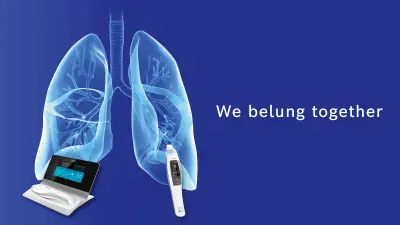New asthma guideline 2023 gives FeNO a tailwind

New asthma guideline
On March 21, 2023, the German Society of Pneumology and Respiratory Medicine (Deutsche Gesellschaft für Pneumologie und Beatmungsmedizin e.V.) published the new "S2k guideline for specialist diagnosis and therapy of asthma."1 It replaces the previous guideline from 20172 and is valid until February 29, 2028. Germany's most important asthma guideline for specialists emphasizes FeNO measurement as a central tool for the diagnosis and therapy of asthma.
Asthma guideline and FeNO – what is new?
In contrast to the previous guideline, various important changes have been made. Particularly noteworthy are the innovations regarding FeNO measurement. For the first time, FeNO is described as an indispensable component of specialist asthma diagnostics. The clinical algorithm for asthma diagnostics in children and adolescents as well as adults has also been adapted. Here, the following statements can be made about FeNO measurement:
- With the new diagnostic algorithm for children and adolescents, FeNO measurement is recommended in almost all affected individuals with typical asthma symptoms.
- With the new diagnostic algorithm for adults, FeNO measurement is helpful and adds diagnostic value especially in unclear cases.
- For the first time, a diagnosis of asthma can be made with FeNO in combination with response to ICS in cases of asthma symptoms and inconspicuous hyperresponsiveness.
It should be noted that a clinical diagnosis of asthma can only be made by combining different diagnostic procedures.
Importance of FeNO measurement for diagnostics
The new guideline states that "measurement of airway inflammation by FeNO is an important component in the diagnosis and management of asthma and is indispensable as a diagnostic tool in pneumology specialist practice." Therefore, the biomarker FeNO has been included as an important component in the new clinical diagnostic algorithms.
In the last guideline published in 20172, FeNO measurement was already considered to have diagnostic utility. In the meantime, numerous scientific findings are available that further support the value of FeNO measurement in asthma diagnostics and therapy.
Determination of FeNO is helpful in confirming the diagnosis of asthma, especially in patients without regular ICS therapy.3 The higher the FeNO value, the more likely the diagnosis of asthma.4 A significantly elevated FeNO value (≥ 50 ppb), especially with concomitant evidence of a blood eosinophil increase (≥ 300/μl), is indicative of an increased risk of exacerbation.5,6
Importance of FeNO measurement for therapy control
The new guideline also highlights the increasing importance of FeNO measurement for asthma therapy. Not only to monitor therapy adherence and allergen exposure, but also to monitor and predict medication response.
Thus, patients with elevated FeNO levels are usually ICS-responsive.7,8 If the diagnosis of asthma is confirmed and the FeNO level is above 50 ppb, a response to ICS is very likely and medication is usually recommended even if the patient is asymptomatic. If the FeNO level is less than 25 ppb, ICS medication can, where appropriate, be reduced.
In patients with severe asthma who are candidates for biologics therapy, a FeNO value above 20 ppb is considered predictive of drug response.
FeNO can be used to help assess treatment adherence: elevated FeNO levels during ICS therapy may reflect poor adherence to therapy. 9 However, persistently elevated FeNO levels despite ICS therapy may also indicate the presence of airway inflammation that does not respond to an ICS dose increase.10
FeNO measurements are useful in pregnant asthma patients because the ICS dose can be reduced based on the measurement results if asthma control is good.11
FeNO measurement with Vivatmo from Bosch
Bosch Healthcare Solutions has been offering professional FeNO monitoring for medical practices and clinics since 2017. The FeNO measuring device Vivatmo pro was developed specifically for use in the medical practice and clinic environment. In addition, we have developed Vivatmo me, the first and only home FeNO measuring device for asthma patients. It is designed to support asthma patients and their physicians in the active management of the disease.
Sources:
1S2k-Leitlinie zur fachärztlichen Diagnostik und Therapie von Asthma 2023: https://register.awmf.org/assets/guidelines/020-009l_S2k_Fachaerztliche-Diagnostik-Therapie-von-Asthma_2023-03.pdf
2Buhl R, Bals R, Baur X et al. [Guideline for the Diagnosis and Treatment of Asthma - Guideline of the German Respiratory Society and the German Atemwegsliga in Cooperation with the Paediatric Respiratory Society and the Austrian Society of Pneumology]. Pneumologie 2017; 71: e3. DOI: 10.1055/a-0790-0021
3Pedrosa M, Cancelliere N, Barranco P et al. Usefulness of exhaled nitric oxide for diagnosing asthma. J Asthma 2010; 47: 817-821. DOI: 10.3109/02770903.2010.491147
4Karrasch S, Linde K, Rücker G et al. Accuracy of FENO for diagnosing asthma: a systematic review. Thorax 2017; 72: 109-116. DOI: 10.1136/thoraxjnl-2016-208704
5Kraft M, Brusselle G, FitzGerald JM et al. Patient characteristics, biomarkers and exacerbation risk in severe, uncontrolled asthma. Eur Respir J 2021; 58. DOI: 10.1183/13993003.00413-2021
6Couillard S, Laugerud A, Jabeen M et al. Derivation of a prototype asthma attack risk scale centred on blood eosinophils and exhaled nitric oxide. Thorax 2022; 77: 199-202. DOI: 10.1136/thoraxjnl-2021-217325
7Dweik RA, Boggs PB, Erzurum SC et al. An official ATS clinical practice guideline: interpretation of exhaled nitric oxide levels (FENO) for clinical applications. Am J Respir Crit Care Med 2011; 184: 602-615. DOI: 10.1164/rccm.9120-11ST
8Loewenthal L, Menzies-Gow A. FeNO in Asthma. Semin Respir Crit Care Med 2022; 43: 635-645. DOI: 10.1055/s-0042-1743290
9Butler CA, Heaney LG. Fractional exhaled nitric oxide and asthma treatment adherence. Curr Opin Allergy Clin Immunol 2021; 21: 59-64. DOI: 10.1097/aci.0000000000000704
10125. Couillard S, Shrimanker R, Lemaire-Paquette S et al. Longitudinal changes in sputum and blood inflammatory mediators during FeNO suppression testing. Thorax 2022; 77: 933-938. DOI: 10.1136/thoraxjnl-2021-217994
11126. Powell H, Murphy VE, Taylor DR et al. Management of asthma in pregnancy guided by measurement of fraction of exhaled nitric oxide: a double-blind, randomised controlled trial. Lancet 2011; 378: 983-990. DOI: 10.1016/s0140-6736(11)60971-9
This website contains general product information about the Vivatmo system from Bosch. Not all products and their functions mentioned here are approved in every regional market. For a detailed description of the products and features as well as information on intended and safe use, please refer to your locally authorized Bosch distribution partner and the instructions for use that are valid for your country.



